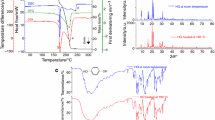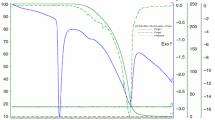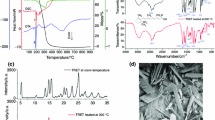Abstract
Differential Scanning Calorimetry (DSC), thermogravimetry/derivative thermogravimetry (TG/DTG) and infrared spectroscopy (IR) techniques were used to investigate the compatibility between prednicarbate and several excipients commonly used in semi solid pharmaceutical form. The thermoanalytical studies of 1:1 (m/m) drug/excipient physical mixtures showed that the beginning of the first thermal decomposition stage of the prednicarbate (T onset value) was decreased in the presence of stearyl alcohol and glyceryl stearate compared to the drug alone. For the binary mixture of drug/sodium pirrolidone carboxilate the first thermal decomposition stage was not changed, however the DTG peak temperature (T peak DTG) decreased. The comparison of the IR spectra of the drug, the physical mixtures and of the thermally treated samples confirmed the thermal decomposition of prednicarbate. By the comparison of the thermal profiles of 1:1 prednicarbate:excipients mixtures (methylparaben, propylparaben, carbomer 940, acrylate crosspolymer, lactic acid, light liquid paraffin, isopropyl palmitate, myristyl lactate and cetyl alcohol) no interaction was observed.



















Similar content being viewed by others
References
Hardy MJ. Drug-excipient compatibility prediction by DSC. Anal Proc. 1982;19:556–7.
Smith A. Use of thermal analysis in predicting drug-excipient interactions. Anal Proc. 1982;19:559–61.
Giron D. Applications of thermal analysis in the pharmaceutical industry. J Pharm Biomed Anal. 1986;4:755–70.
Cides LCS, Araújo AAS, Santos-Filho M, Matos JR. Thermal behaviour, compatibility study and decompositions kinectics of glimepiride under isothermal and non-isothermal conditions. J Therm Anal Calorim. 2006;84:441–5.
Rezende RLO, Santoro MIRM, Matos JR. Stability and compatibility study on enalapril maleate using thermoanalytical techniques. J Therm Anal Calorim. 2008;93(3):881–6.
Fiese EF, Hagen TA. Pré-formulação. In: Lachman L, Lieberman HA, Kanig JL, editors. Teoria e prática na indústria farmacêutica, vol. 2. Lisboa: Fundação Calouste Gulbenkian; 2001. p. 651.
Souza FS, Macedo RO, Veras JWE. Studies of cimetidine pre-formulated and tablets for TG and DSC coupled to the photovisual system. Thermochim Acta. 2002;392–393:99–106.
Araújo AAS, Storpirtis S, Mercuri LP, Carvalho FMS, Santos-Filho M, Matos JR. Thermal analysis of the antiretroviral zidovudine (AZT) and evaluation of the compatibility with excipients used in solid dosage forms. Int J Pharm. 2003;260:303–14.
Tomassetti M, Catalani A, Rossi V, Vecchio S. Thermal analysis study of the interactions between acetaminophen and excipients in solid dosage forms and in some binary mixtures. J Pharm Biomed Anal. 2005;37:949–55.
Mura P, Furlanetto S, Cirri M, Maestrelli F, Marras AM, Pinzauti S. Optimization of glibenclamide tablet composition through the combined use of differential scanning calorimetry and D-optimal mixture experimental design. J Pharm Biomed Anal. 2005;37:65–71.
Fleischer AB. Atopic dermatitis. Perspectives on a manageable disease. Postgrad Med. 1999;106(4):49–53.
Cornell RC, Cherill RJ, Abrams BB. Safety of prednicarbate emollient cream 0.1% and ointment 0.1%, nonhalogenated, midpotency topical steroid formulations. J Geriatr Dermatol. 1994;2:57–65.
Gupta AK, Chow M. Prednicarbate (Dermatop): a review. J Drugs Dermatol. 2004;3(5):553–6.
Macnally NJ, Phillips DR, Williams HC. The problem of atopic eczema: aetiological clues from the environment and lifestyles. Soc Sci Med. 1998;46(6):729–41.
Fennessy M, Coupland S, Popay J, Naysmith K. The epidemiology and experience of atopic eczema during childhood: a discussion paper on the implications of current knowledge for health care, public health policy and research. Epidemiol Community Health. 2000;54:581–9.
Acknowledgements
The authors acknowledge to Conselho Nacional de Desenvolvimento Científico e Tecnológico (CNPq), Coordenação de Aperfeiçoamento de Pessoal de Nível Superio (CAPES), Fundação de Amparo à Pesquisa do Estado de São Paulo (FAPESP) and Stiefel Laboratories for the financial support.
Author information
Authors and Affiliations
Corresponding authors
Rights and permissions
About this article
Cite this article
Neto, H.S., Novák, C. & Matos, J.R. Thermal analysis and compatibility studies of prednicarbate with excipients used in semi solid pharmaceutical form. J Therm Anal Calorim 97, 367 (2009). https://doi.org/10.1007/s10973-009-0234-x
Published:
DOI: https://doi.org/10.1007/s10973-009-0234-x




